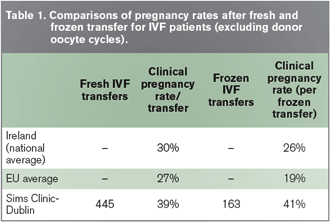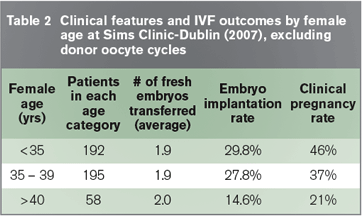Ir Med J. 2008 Oct;101(9):288.
Sir,
We read with interest the recent paper by Mocanu et al1 comparing IVF success rates after fresh zygote transfer and frozen zygote transfer (FZT), which gives further reassurance on the safety of cryopreservation with IVF. Their findings from patients treated in 2001 are parallel to current results at our institution, where no important differences in reproductive outcome were evident. Table 1 summarises similar relationships across larger reference populations.

Mocanu et al also noted that 28% of their frozen human zygotes failed to survive thaw, and a substantially higher miscarriage rate was observed after FZT compared to fresh transfer (29% vs. 18.3%). This rate of embryo loss after thaw could be a reflection of better embryos being transferred fresh, but might also relate to specific freeze/thaw techniques. The authors are probably correct that poor embryo survival may simply be a manifestation of defective early development, and as a result we have advocated liberal use of extended in vitro culture to support those embryos most suitable for transfer2. Recent work has concluded that single blastocyst transfer (done at day 5-6) is preferable to single zygote transfer (done at day 2), since this enables improved cumulative pregnancy rates by transferring a limited number of more advanced embryos. Blastocyst transfer also lowers higher-order multiple gestation risk with IVF, by allowing fewer embryos to be transferred3,4.

Female age may have been one factor contributing to the IVF outcomes observed by Mocanu et al, although their analysis did not include pregnancy data stratified by patient age. At our institution the number of fresh embryos transferred, implantation rates, as well as pregnancy rates after IVF are all adversely influenced by increasing female age, as shown in Table 2.
We concur with Mocanu et al that best clinical practice promotes this conservative approach where the number of embryos normally transferred per patient does not exceed two, especially in the younger patient.
While Ireland has no national public registry to access IVF outcomes data for now, Mocanu et al give a welcome report underscoring the need for such a service. Likewise, ongoing quality management systems in place here will promote reporting of IVF outcomes data in a timely and independently verifiable manner, in compliance with guidelines established by the European IVF Monitoring group. Further monitoring of outcomes following fresh and frozen transfers in IVF is anticipated to corroborate these data published by Mocanu et al.
ES Sills, DJ Walsh, APH Walsh,
The Sims Institute/Sims International Fertility Clinic Dublin 14
Email: [email protected]
References
- Mocanu EV, Cottell E, Waite K, Hennelly B, Collins C, Harrison WF. Frozen-thawed transfer cycles: Are they comparable with fresh? Ir Med J 2008;101:181-4.
- Sills ES, Sweitzer CL, Morton PC, Perloe M, Kaplan CR, Tucker MJ. Dizygotic twin delivery following in vitro fertilization and transfer of thawed blastocysts cryopreserved at day 6 and 7. Fertil Steril 2003;79:424-7.
- Blake DA, Farquhar CM, Johnson N, Proctor M. Cleavage stage versus blastocyst stage embryo transfer in assisted conception. Cochrane Database Syst Rev 2007 Oct;CD002118.
- Papanikolaou EG, Kolibianakis EM, Tournaye H, et al. Live birth rates after transfer of equal number of blastocysts or cleavage-stage embryos in IVF. A systematic review and meta-analysis. Hum Reprod 2008;23:91-9.